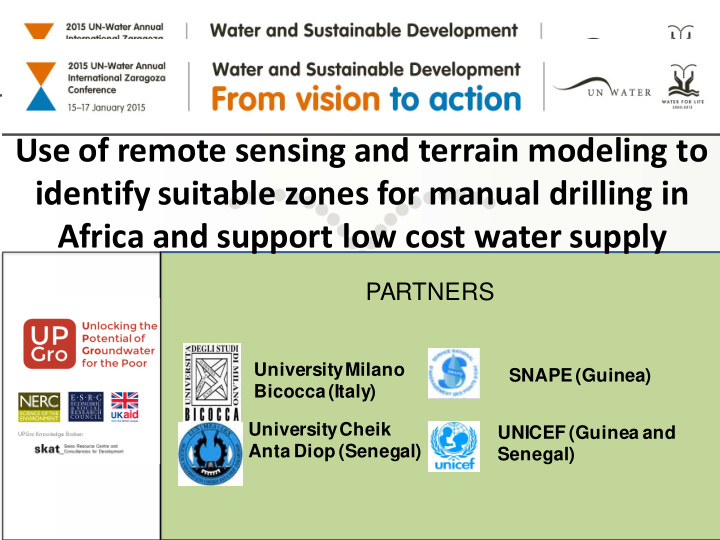



Use of remote sensing and terrain modeling to identify suitable zones for manual drilling in Africa and support low cost water supply PARTNERS University Milano SNAPE (Guinea) Bicocca (Italy) University Cheik UNICEF (Guinea and Anta Diop (Senegal) Senegal)
MANUAL DRILLING techniques of drilling boreholes for groundwater exploitation using human or animal power (not mechanized equipment). These techniques are well known in countries with large alluvial deposits (India, Nepal, Bangladesh, etc) High quality hand drilled wells can provide sustainable and clean water supply
Advantages of manual drilling Limitations of manual drilling Cheaper than mechanized boreholes Manual drilling is feasible only under Easy to implement with locally made hydrogeological suitable conditions Soft unconsolidated shallow geological equipment “manual work intensive” and not layers Water level not too deep “capital intensive” ; source of income for Good hydraulic conductivity of shallow local groups porous aquifers IT IS IMPORTANT TO IDENTIFY THOSE ZONES WHERE HYDROGEOLOGICAL CONDITIONS ARE SUITABLE FOR MANUAL DRILLING. MAPS OF SUITABLE ZONES HAVE BEEN COMPLETED IN 15 COUNTRIES SINCE 2008
OBJECTIVE OF THE RESEARCH Integration of direct hydrogeological information from existing database with indirect parameters from Remote Sensing and terrain modeling to characterize shallow aquifers and identify suitable zones for manual drilling DURATION November 2013 – April 2015 STUDY AREA REGION OF LOUGA – KEBEMER (NORTH WEST SENEGAL REGION OF KANKAN AND FARANAH (EAST GUINEA)
Role of partners and external stakeholders ACTIVITY ACADEMIA NATIONAL INTERNATIONAL INSTITUTIONS ORGANISATIONS SCIENTIFIC RESEARCH -UNIVERSITY MILANO AND BICOCCA (IT) CAPACITY BUILDING -UNIVERSITY CHEIK ANTA DIOP (SEN) -University of Thies (SEN) DISSEMINATION As above - UNICEF INTEGRATION -SNAPE (Guinea) RESEARCH INTO - DGPRE (Sen) NATIONAL STRATEGY FOR WATER SUPPLY COORDINATION WITH -UNIVERSITY MILANO -SNAPE (Guinea) - UNICEF MANUAL DRILLING BICOCCA (IT) - Practica PROGRAM FUNDING NERC (UK) - scientific research UNICEF (with external donors) for manual drilling in Guinea
Scientific approach Thematic maps, Remote Sensing (optical, radar), Digital terrain model Geo-Environmental indicators (Geology, Soil, Morphometry, Vegetation dynamics, Soil moisture, Thermal Inertia) (Geo)Statistical model Map of suitable zones for manual drilling Hydrogeological features at observation points Borehole logs interpretation, pump test, geophysics
Source of data THE RESEARCH IS BASED ON AVAILABLE AND FREE OF COST DATA AND WITH LIMITED COST FOR FIELD DATA COLLECTION. THIS FACILITATE THE EXTENSION OF THIS METHOD TO OTHER REGIONS, Free satellite images NATIONAL DATABASE OF (MODIS) WATER POINT Radar images (obtained from European Space Agency free of cost) THEMATIC MAPS
Preliminary results achieved Extraction of environmental parameters from remote sensing VEGETATION DYNAMICS - DRY SEASON MEAN NDVI 0.1 0.25 Estimating feasibility and potential for manual drilling at LOUGA borehole positions
Expected final outputs - Definition and validation of structured method to infer shallow hydrogeology and suitability for manual drilling from indirect data - Generation of maps of suitability for manual drilling in 2 study area Factor of success FACTORS OF SUCCESS - Collaboration between partners -Coordination between scientific research, training of drilling teams, implementation of hand drilled wells in target zones, advocacy - Deep Involvement by national institution (SNAPE) - Active role of UNICEF in support and fund raising
Thanks very much for the attention
Recommend
More recommend